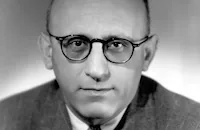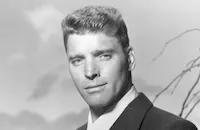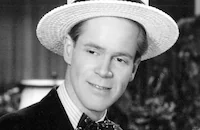Criss Cross

Brief Synopsis
Cast & Crew
Robert Siodmak
Burt Lancaster
Yvonne De Carlo
Dan Duryea
Stephen Mcnally
Esy Morales
Film Details
Technical Specs

Synopsis
In the parking lot of the Round-Up bar in Los Angeles, Steve Thompson meets secretly with his married lover, Anna Dundee, and reassures her that their plan to run away together will not fail. Steve then fights with Anna's gangster husband Slim inside the bar, but police lieutenant Pete Ramirez, Steve's old friend, breaks it up. Steve refuses to press charges against Slim, who is supposedly leaving for Detroit the next day, and Pete, disgusted by Steve's destructive behavior, leaves. Unknown to Pete, Steve, Slim and his gang are plotting to rob an armored truck, which will be driven by Steve, who works for an armored car company, and staged the fight to fool Pete. The next morning, as Steve and Pop, a co-worker and family friend, leave on their scheduled payroll run, Steve recalls the events that led him to commit robbery: Eight months before, Steve returns to his home in Los Angeles after two years of drifting. Although he fights the urge to see Anna, to whom he had been briefly married, he starts dropping by the Round-Up, the bar they used to frequent together. Eventually, he and Anna reunite, and she chastises him for not contacting her sooner. Passion between the combative couple quickly reignites, and they begin seeing each other again. Steve's renewed romance distresses both his mother and Pete, who distrust the manipulative Anna. Pete is particularly concerned because he knows that Slim is also after Anna. Then one night, Steve learns that Anna has gone to Yuma to marry Slim. Although embittered, Steve cannot resist Anna when he later runs into her at Union Station. Slim has gone to Las Vegas, and Anna meets secretly with Steve, complaining that she is miserable. Anna shows Steve bruises on her back inflicted by the controlling, brutal Slim and tells Steve that she married Slim, who had been pursuing her since their divorce, only because Pete had threatened to send her to prison if she continued to see Steve. Later, a drunken Steve confronts Pete, who admits he threatened Anna, but warns his friend about crossing Slim. Steve continues to see Anna, but one day, she comes by his house and informs him that Slim has found out about their affair. At that moment, Steve discovers Slim and his thugs in his living room. Thinking fast, Steve tells Slim that he summoned Anna to his house in order to discuss his plan for an armored car robbery. After Steve convinces Slim that they can pull off the payroll heist, the first of its kind in many years, because he will be their "inside man," Slim gathers his men together and carefully plots every detail of the robbery. Part of the plan is to broadcast that Slim is leaving for Detroit on the same day as the proposed robbery and throw a going-away party at the Round-Up the night before. Back in the present, Steve drives his truck to the appointed spot, where Slim and his men fire tear gas at Steve and Pop. Pop then begins shooting at the robbers, who return fire, fatally wounding him. Enraged because Slim had agreed not to harm Pop, Steve shoots Slim and is himself badly wounded. Slim and his gang flee with the money before the police arrive, and Steve wakes up later in a hospital. Although Steve's family and the public believe that he is a hero, Pete has deduced Steve's involvement and warns him that Slim will be after him if Anna has disappeared. Panicked, Steve, who had arranged for Anna to meet him in a Palos Verdes cottage, asks Nelson, a man he believes is visiting his sick wife, to watch the door for him during the night. The next morning, Nelson reveals that he is Slim's hired killer and drags Steve from the hospital. As they are driving to see Slim, Steve bribes Nelson into taking him to Anna. As soon as Steve pays Nelson off, a terrified Anna starts to pack, telling Steve that he is not strong enough to go with her, and she is not tough enough to stand by him. Before she can escape, however, Slim, having anticipated that Steve would bribe Nelson, bursts in. As police cars close in, Slim shoots the couple dead.

Director

Robert Siodmak
Cast

Burt Lancaster

Yvonne De Carlo

Dan Duryea

Stephen Mcnally
Esy Morales
Tom Pedi
Percy Helton

Alan Napier

Griff Barnett
Meg Randall

Richard Long
Joan Miller
Edna M. Holland

John Doucette
Marc Krah
James O'rear
John "skins" Miller
Robert Osterloh
Vincent Renno
Charles Wagenheim

Anthony Curtis
Beatrice Roberts
Isabel Randolph
Stephen Roberts
Garry Owen
Kenneth Patterson

Gene Evans
George Lynn
Michael Cisney
Robert Winkler
Lee Tung Foo
Ann Staunton
Jeraldine Jordan
Kippee Valez
Dolores Castle
Vito Scotti
Diane Stewart
Jean Bane
Timmy Hawkins
John Roy
Crew
Bert Anderson
Leslie I. Carey
Richard Deweese
Carmen Dirigo
Connie Earl
Oliver Emert
Fred Frank
Daniel Fuchs
Russell A. Gausman
Stanley Gulliver
Bernard Herzbrun
Jack Hively
David S. Horsley
Ted J. Kent
Michel Kraike
Nord Kurland
Boris Leven
Gale Mcgarry
Esy Morales
Frank Planer
Dave Ragin
Miklos Rozsa
Keith Weeks
Bud Westmore
Yvonne Wood
Ernest Young
Peter Zinner

Videos
Movie Clip



Trailer
Hosted Intro
Film Details
Technical Specs

Articles
Criss Cross
Criss Cross was slated to star up-and-coming actor Burt Lancaster, with a script by Anthony Veiller. It was also to be directed by Robert Siodmak, and produced by Mark Hellinger, reuniting the team responsible for the successful noir thriller The Killers (1946). Before it went into production, however, Hellinger died (in December 1947), and the board of directors of Hellinger's production company voted to sell the property and two other projects to Universal to pay off debts. Siodmak's and Lancaster's contracts came as part of the deal, but Lancaster didn't want to do the film without Hellinger. He was offered several ways out of his potential breach of contract, but none of them panned out. So in June 1948, Lancaster reported to the set, along with co-stars Yvonne De Carlo, Dan Duryea, and Stephen McNally.
Although based on a 1936 novel by Don Tracy, Siodmak and writer Daniel Fuchs reworked the story to include many of the elements of The Killers, an Ernest Hemingway story. Lancaster, not yet identified with the forceful, athletic action roles that would make him a major star in the next few years, once again played the well-meaning but somewhat dim-witted hunk easily duped by his obsession with a beautiful, two-timing woman. De Carlo, getting her first chance to show some real acting ability, took on the femme fatale role similar to the one Ava Gardner played in the earlier picture.
The expatriate Siodmak also borrowed heavily from Sturme der Leidenschaft (1932), a film he made in Germany before the Nazis came to power, forcing him into exile. Fully exploring the themes he dealt with throughout his career - characters driven by personal obsessions and an inexorable sense of fatalism - Siodmak brought a highly stylized German expressionism to bear on the complex narrative and realistic location shooting. Equally important to the film's look and influence is the rich cinematography of Franz Planer (billed as "Frank" in the credits), who had filmed Max Ophuls' Liebelei (1933) and Letter from an Unknown Woman (1948). Planer beautifully captured the texture of such memorable settings as Los Angeles' Union Station in the blazing summer heat; a bar that is crowded and lively by night and dingy and depressing by day; the shabby decay of the city's Victorian Bunker Hill section; and the stark contrast of light and shadow that was a hallmark of the German artists who did so much to shape the look and style of American film noir.
Criss Cross is also justly famous for its opening, which places the audience immediately in the middle of a fierce argument in full swing between Lancaster and De Carlo. Rather than the usual linear method of exposition, the device plops us into the middle of the story, with the background details revealed in flashbacks and the robbery and aftermath rushing headlong toward the tragic conclusion.
Although reluctant to do the picture, Lancaster got on well with Siodmak, who was patient with the often difficult young actor's brooding method. "He's just the same [as he was in The Killers], except a better actor," Siodmak said of Lancaster at the time. "He still fights me when he doesn't want to do a scene as I outline it. But he did that before, too, when he knew nothing about pictures. You have to give him a reason for everything. Once you do, he's easy to direct."
Lancaster also got on well with a young actor making his debut in an uncredited bit as an oily gigolo who dances a frenetic rumba with De Carlo - Tony Curtis. Although the butt of several of Lancaster's crazy practical jokes, Curtis realized the pranks were a sign of acceptance and fondness, and the two became fast friends. They worked together three more times: Trapeze (1956), Sweet Smell of Success (1957), and The List of Adrian Messenger (1963), the first two also produced by Lancaster.
The story was remade by Steven Soderbergh as Underneath (1995). Two other movies were released under the title Criss Cross, in 1992 and 1996, but they aren't related to this film.
Director: Robert Siodmak
Producer: Michael Kraike
Screenplay: Daniel Fuchs, based on the novel by Don Tracy
Cinematography: Franz Planer
Editing: Ted J. Kent
Art Direction: Bernard Herzbrun, Boris Leven
Original Music: Miklos Rozsa
Cast: Burt Lancaster (Steve Thompson), Yvonne De Carlo (Anna Dundee), Dan Duryea (Slim Dundee), Stephen McNally (Det. Ramirez), Esy Morales (Orchestra leader), Percy Helton (Frank), Alan Napier (Finchley).
BW-88m. Closed captioning.
by Rob Nixon

Criss Cross
Quotes
She's all right, she's just young.- Steve Thompson
Huh! Some ways, she knows more than Einstein.- Mrs. Thompson
Trivia
Notes
Voice-over narration, spoken by Burt Lancaster as his character "Steve Thompson," is heard intermittently throughout the last two-thirds of the picture. The order of the opening credits differs from the end credits. In the opening credits, Richard Long and Meg Randall are listed after Stephen McNally, and Esy Morales and His Rhumba Band are listed last. Early Hollywood Reporter production charts include a "Miss X" in the cast, and later ones include Meg McClure. Publicity material indicates that while Universal was coming up with a stage name for newcomer Randall, whose real name was Gene Roberts, she was referred to as "Miss X." It is possible that Meg McClure was an early version of Randall's stage name. Actor Tony Curtis, who was unbilled on the film but at that time was known as Anthony or James Curtis, made his screen acting debut in the film, as did Puerto Rican band leader Morales.
Contemporary news items provide the following information about the production: Universal purchased Don Tracy's novel from the estate of producer-writer Mark Hellinger. Criss Cross was to have been Hellinger's first production away from Universal, and the first of his Valley Studio company. Some news items commented that Criss Cross was to be shot in the same semi-documentary style as Hellinger's final picture, The Naked City . Hellinger, who died in 1947, reportedly wanted Lancaster for the starring role, and the deal that Universal struck with Valley Studio included the actor's services. According to modern sources, both Lancaster and Siodmak were obligated to work on Criss Cross as part of their contracts with Hellinger's estate. Modern sources also note that Hellinger's original story idea had a racetrack setting. Anthony Veiller was announced as screenwriter in March 1948, but his contribution to the final film has not been confirmed. Jules Schermer was the film's original producer; Michel Kraike took over the project shortly before the start of principal photography. H. B. Warner and Rene Touzet were listed as cast members, but their appearance in the final film has not been confirmed. Scenes were filmed in and around Los Angeles, including Union Station, Angel's Flight, Bunker Hill, Terminal Island and a Spring Street hotel. Explosives experts Nick Carmona and Del Crawford were injured during production when a smoke bomb exploded prematurely inside the special effects department.
On October 10, 1949, the Hallmark Playhouse broadcast a radio adaptation of the story, also starring Burt Lancaster.

Miscellaneous Notes
Released in United States on Video April 7, 1988
Released in United States Winter January 12, 1949
Re-released in United States on Video January 17, 1995
Re-released in United States on Video May 14, 1996
Formerly distributed by MCA Home Video.
Completed shooting July 28, 1948.
Released in United States Winter January 12, 1949
Re-released in United States on Video January 17, 1995
Released in United States on Video April 7, 1988
Re-released in United States on Video May 14, 1996















